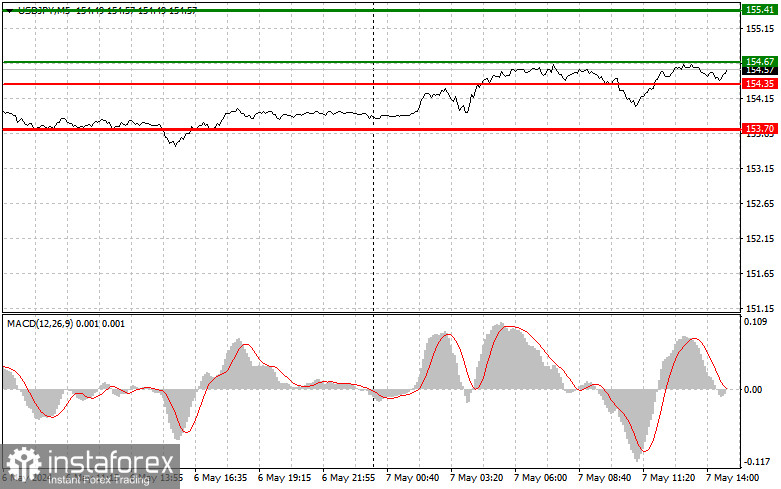Trade analysis and tips for trading the Japanese yen
The test of the price at 154.13 in the first half of the day occurred when the MACD indicator had dropped significantly below the zero mark, limiting the downward potential of the pair - especially against the bullish market. Unfortunately, there was no second test of this price, which prevented me from entering the market to buy the dollar. The technical picture changed for the second half of the day, but it is unlikely that we can expect strong and directional movement in either direction. Data on the RCM/TIPP Economic Optimism Index and consumer credit volume are not important to the market, especially for the dollar against the Japanese yen. Therefore, I will also look for suitable entry points for trading within the channel. And if I decide to act on a breakout, it is better within the framework of further bullish trend development. As for the intraday strategy, I plan to act based on scenarios No. 1 and No. 2.

Buy signal
Scenario No. 1: Today, I plan to buy USD/JPY when the entry point reaches around 154.67 (green line on the chart), with a target of rising to 155.41 (thicker green line on the chart). At the point of 155.41, I will exit purchases and open sales in the opposite direction (expecting a movement of 30-35 points in the opposite direction from the level). Expecting the pair to rise today in continuation of the bullish market. Important! Before buying, make sure that the MACD indicator is above the zero mark and is just starting to rise from it.
Scenario No. 2: I also plan to buy USD/JPY today in case of two consecutive tests of the price at 154.35 when the MACD indicator is in the oversold area. This will limit the downward potential of the pair and lead to a reverse market turnaround upwards. Expect a rise to the opposite levels of 154.67 and 155.41.
Sell signal
Scenario No. 1: Today, I plan to sell USD/JPY after the level of 154.35 is updated (red line on the chart), leading to a rapid decline in the pair. The key target for sellers will be the level of 153.70, where I will exit sales and immediately open purchases in the opposite direction (expecting a movement of 20-25 points in the opposite direction from the level). Pressure on the pair will return in case of weak US data. Important! Before selling, make sure that the MACD indicator is below the zero mark and is just starting to decrease from it.
Scenario No. 2: I also plan to sell USD/JPY today in case of two consecutive tests of the price at 154.67 when the MACD indicator is in the overbought area. This will limit the upward potential of the pair and lead to a reverse market turnaround downwards. Expect a decline to the opposite levels of 154.35 and 153.70.

What's on the chart:
Thin green line - entry price at which the trading instrument can be bought;
Thick green line - expected price, where Take Profit can be placed, or profits can be fixed independently, as further growth above this level is unlikely;
Thin red line - entry price, at which the trading instrument can be sold;
Thick red line - expected price, where Take Profit can be placed, or profits can be fixed independently, as further decline below this level is unlikely;
MACD indicator. When entering the market, it is important to follow the overbought and oversold zones.
Important. Beginner traders in the Forex market need to make decisions about entering the market very carefully. It is best to stay out of the market before important fundamental reports are released to avoid being caught in sharp exchange rate fluctuations. If you decide to trade during news releases, always place stop orders to minimize losses. You must place stop orders to lose your entire deposit quickly, especially if you do not use money management and trade with large volumes.
And remember, for successful trading, it is necessary to have a clear trading plan similar to the one presented above. Spontaneous trading decisions based on the current market situation are initially a losing strategy for an intraday trader.





















